Wichita, Kansas 作者: 来源: 发布时间:2021-11-04
I.Population and Area
₋Area
Land: 159.29 sq mi (412.56 km2)
₋Population
Total: 382,362
Density: 2,300/sq mi (900/km2)
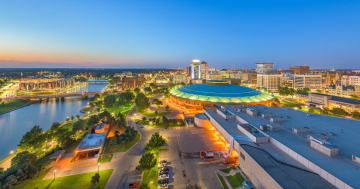
II.Natural Geography
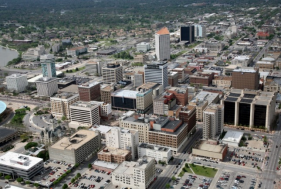
Downtown in Wichita
₋Wichita (/ˈwɪtʃɪtɔː/ WITCH-i-taw) is the largest city in the U.S. state of Kansas and the county seat of Sedgwick County. As of 2019, the estimated population of the city was 389,938. Wichita is the principal city of the Wichita metropolitan area which had an estimated population of 644,888 in 2018.
₋Located in south-central Kansas on the Arkansas River, Wichita began as a trading post on the Chisholm Trail in the 1860s and was incorporated as a city in 1870. It became a destination for cattle drives traveling north from Texas to Kansas railroads, earning it the nickname "Cowtown."
₋In the 1920s and 1930s, businessmen and aeronautical engineers established aircraft manufacturing companies in Wichita, including Beechcraft, Cessna, and Stearman Aircraft. The city became an aircraft production hub known as "The Air Capital of the World." Textron Aviation, Learjet, Airbus, and Spirit AeroSystems continue to operate design and manufacturing facilities in Wichita, and the city remains a major center of the American aircraft industry. Wichita is also home to McConnell Air Force Base, and Wichita Dwight D. Eisenhower National Airport, the largest airport in Kansas.
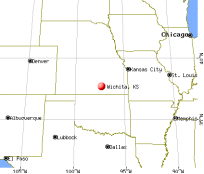
₋As an industrial hub, Wichita is a regional center of culture, media, and trade. It hosts several universities, large museums, theaters, parks, and entertainment venues, notably Intrust Bank Arena and Century II Performing Arts & Convention Center. The city's Old Cowtown Museum maintains historical artifacts and exhibits on the city's early history. Wichita State University is the third-largest post-secondary institution in the state.
III.ECONOMY
₋The average salary in Wichita, KS is $16.38. Trends in wages decreased by -0.1 percent in Q1 2020. The cost of living in Wichita, KS is 8 percent higher than the national average. The most popular occupations in Wichita, KS are Certified Nurse Assistant (CNA), Registered Nurse (RN), and Administrative Assistant which pay between $10.52 and $27.13 per year. The most popular employers in Wichita, KS are Via Christi, Wesley Medical Center, LLC, and Spirit Aerosystems, Inc..
₋Website: https://www.payscale.com/research/US/Location=Wichita-KS/Salary
IV.Industrial Characteristics
₋It is the birthplace of famous restaurants such as White Castle and Pizza Hut. A survey of well-known Kansas-based brands conducted by RSM Marketing Services and the Wichita Consumer Research Center showed many of the top 25 Kansas-based brands such as Koch, Coleman, Cessna, Pizza Hut, Beechcraft, Freddy's and more are based in Wichita
₋Wichita's principal industrial sector is manufacturing, which accounted for 21.6 percent of area employment in 2003. Aircraft manufacturing has long dominated the local economy, and plays such an important role that it has the ability to influence the economic health of the entire region; the state offers tax breaks and other incentives to aircraft manufacturers.
₋Healthcare is Wichita's second-largest industry, employing approximately 28,000 people in the local area. Since healthcare needs remain fairly consistent regardless of the economy, this field was not subject to the same pressures that affected other industries in the early 2000s. The Kansas Spine Hospital opened in 2004, as did a critical care tower at Wesley Medical Center. In July 2010, Via Christi Health, which is the largest provider of healthcare services in Kansas, opened a hospital that will serve the northwest area of Wichita. Via Christi Hospital on St. Teresa is the system's fifth hospital to serve the Wichita community. In 2016, Wesley Healthcare opened Wesley Children's Hospital, the first and only children's hospital in the Wichita area.
₋Thanks to the early 20th-Century oil boom in neighboring Butler County, Kansas, Wichita became a major oil town, with dozens of oil exploration companies and support enterprises. Most famous of these was Koch Industries, today a global natural-resources conglomerate. The city was also at one time the headquarters of the former Derby Oil Company, which was purchased by Coastal Corporation in 1988. Wichita is home to oil & natural gas organizations Kansas Strong and Kansas Independent Oil & Gas Association (KIOGA)
₋Koch Industries and Cargill, the two largest privately held companies in the United States, both operate headquarters facilities in Wichita. Koch Industries' primary global corporate headquarters is in a large office-tower complex in northeast Wichita. Cargill Meat Solutions Div., at one time the nation's 3rd-largest beef producer, is headquartered downtown. Other firms with headquarters in Wichita include roller-coaster manufacturer Chance Morgan, gourmet food retailer Dean & Deluca, renewable energy company Alternative Energy Solutions, and Coleman Company, a manufacturer of camping and outdoor recreation supplies. Air Midwest, the nation's first officially certificated "commuter" airline, was founded and headquartered in Wichita and evolved into the nation's 8th largest regional airline prior to its dissolution in 2008.
₋As of 2013, 68.2% of the population over the age of 16 was in the labor force. 0.6% was in the armed forces, and 67.6% was in the civilian labor force with 61.2% employed and 6.4% unemployed. The occupational composition of the employed civilian labor force was: 33.3% in management, business, science, and arts; 25.1% in sales and office occupations; 17.2% in service occupations; 14.0% in production, transportation, and material moving; 10.4% in natural resources, construction, and maintenance. The three industries employing the largest percentages of the working civilian labor force were educational services, health care, and social assistance (22.3%); manufacturing (19.2%); and retail trade (11.0%).
₋The cost of living in Wichita is below average; compared to a U.S. average of 100, the cost of living index for the city is 84.0. As of 2013, the median home value in the city was $117,500, the median selected monthly owner cost was $1,194 for housing units with a mortgage and $419 for those without, and the median gross rent was $690.
₋Wichita has a national reputation in U.S. media as an affordable and pleasant place to live. In July 2006, CNN/Money and Money ranked Wichita ninth on their list of the 10 best U.S. big cities in which to live. In 2008, MSN Real Estate ranked Wichita 1st on its list of most affordable cities. Wichita was also named the most "Uniquely American" city by Newsmax magazine in a May 2009 piece written by Peter Greenberg. However, in its 2019 "Best Places to Live" survey, U. S. News & World Report, ranked Wichita at #79 out of 125 U.S. cities, and noted that violent crime in Wichita had risen over the previous few years. In the 2019 KIDS COUNT Data Book, in its annual "State Rankings on Overall Child Well-Being," Kansas was ranked No. 15 out of the 50 states. However, the state has a significantly higher rate of child incarceration than the nation, generally, and a higher rate of the state taking children from their homes.
₋Aircraft manufacturing
₋From the early to late 20th century, aircraft pioneers such as Clyde Cessna, "Matty" Laird, Lloyd Stearman, Walter Beech, Al Mooney and Bill Lear began aircraft-manufacturing enterprises that would lead to Wichita becoming the nation's leading city in numbers of aircraft produced. The aircraft corporations E. M. Laird Aviation Company (the nation's first successful commercial airplane manufacturer), Travel Air (started by Beech, Stearman and Cessna), Stearman, Cessna, Beechcraft and Mooney were all founded in Wichita between 1920 and early 1932. By 1931, Boeing (of Seattle, Washington) had absorbed Stearman, creating "Boeing-Wichita", which would eventually grow to become Kansas' largest employer.
₋Today, Cessna Aircraft Co. (the world's highest-volume airplane manufacturer) and Beechcraft remain based in Wichita having merged into Textron Aviation in 2014, along with Learjet and Boeing's chief subassembly supplier, Spirit AeroSystems. Airbus maintains a workforce in Wichita, and Bombardier (parent company of Learjet) has other divisions in Wichita as well. Over 50 other aviation businesses operate in the Wichita MSA, as well dozens of suppliers and subcontractors to the local aircraft manufacturers. In total, Wichita and its companies have manufactured an estimated 250,000 aircraft since Clyde Cessna's first Wichita-built aircraft in 1916.
₋In the early 2000s, a national and international recession combined with the after effects of the September 11, 2001 terrorist attacks to depress the aviation sub-sector in and around Wichita. Orders for new aircraft plummeted, prompting Wichita's five largest aircraft manufacturers, Boeing Co., Cessna Aircraft Co., Bombardier Learjet Inc., Hawker Beechcraft and Raytheon Aircraft Co.—to slash a combined 15,000 jobs between 2001 and 2004. In response, these companies began developing small- and mid-sized airplanes to appeal to business and corporate users. In 2007, Wichita built 977 aircraft, ranging from single-engine light aircraft to the world's fastest civilian jet; one-fifth of the civilian aircraft produced in United States that year, plus numerous small military aircraft. In early 2012, Boeing announced it would be closing its Wichita plant by the end of 2013, which paved the road for Spirit Aerosystems to open its plant.
V.Attractions
1.Exploration Place
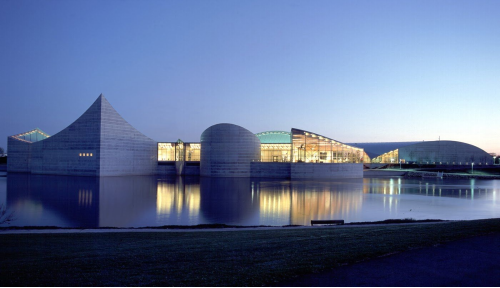
₋Exploration Place is a science museum located on the west side of the Arkansas River in the Delano neighborhood of Wichita, Kansas, United States. It is a 501(c)(3) not-for-profit institution.
₋During the 1980s, a plan to consolidate the city-owned Wichita Omnisphere and Science Center and the Children's Museum of Wichita was proposed. In 1992, a capital funds campaign was launched, and with an endowment from Velma Lunt Wallace, funds from the City of Wichita and Sedgwick County, and other donations, the museum opened in the spring of 2000.
₋The museum is supported by admissions, membership dues, Sedgwick County government, and other public support and voluntary contributions from individuals, corporations and foundations. In 2017 the museum is expected to reach approximately 200,000 attendees.
₋Construction began May 1997 and took 2 ½ years. Internationally acclaimed architect Moshe Safdie of Boston designed the building. There are 100,000 square feet (9,300 m2) and 20 acres (81,000 m2) on the property. The tallest point of the building is the peak of the roof of the traveling exhibits space and is 70 feet (21 m) above the floor (nearly 7 stories high). The combined distance around the interior perimeter of both buildings is approximately one mile.
₋The "Island Building" is named because it is surrounded by water, with the Arkansas River on one side and the reflecting pond on the other. The reflecting pond is between the buildings to create the illusion that looks like the river runs between the buildings. The reflecting pond is one to three feet deep. Even though the building is so close to the river it is not prone to flooding because it is above the 100-year flood level. During the flood in October 1998, the worst in recent history, the water level was still more than 8 feet (2.4 m) below the finished floor level.
₋Address: 300 N McLean Blvd, Wichita, KS 67203, United States
₋Website: https://exploration.org/
2.Keeper of the Plains
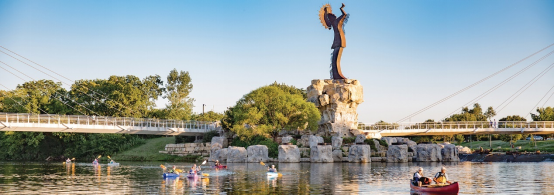
₋The Keeper of the Plains is a 13.4 metres (44 ft) Cor-Ten steel sculpture by Kiowa-Comanche artist Blackbear Bosin. It stands at the confluence of the Arkansas and Little Arkansas rivers in Wichita, Kansas adjacent to the Mid-America All-Indian Center. Surrounding the base of the statue are multiple displays which describe the local tribes that used to inhabit this area, as well as several fire pits which sometimes light up to illuminate the statue at night. The fire pits, which are known as the Rings of Fire, are lit manually for public safety and run in 15-minute increments. They are generally lit once a night around 7 pm during the winter and sunset during the summer.
₋The sculpture, commissioned by the city and private organizations to mark the United States Bicentennial, was erected in 1974. It has since become one of Wichita's most recognized and beloved symbols. A spring/summer 2006 project elevated the sculpture on a 30-foot rock promontory so it could be seen from farther away.
₋A profile image of this statue comprises the motif adopted by the 22nd Air Refueling Wing, a U.S. Air Force flying unit which is based at nearby McConnell Air Force Base. From 1993 through 2004, an image of the statue, along with the words "Keeper of the Plains," appeared on the tails of Boeing KC-135 air refueling tankers assigned to the 22nd ARW.
₋Artist: Blackbear Bosin
₋Address: 339 Veterans Pkwy, Wichita, KS 67203, United States
₋Height: 13 m
₋Phone: +1 316-268-4497
₋Website: https://www.atlasobscura.com/places/keeper-of-the-plains
3.Old Cowtown Museum
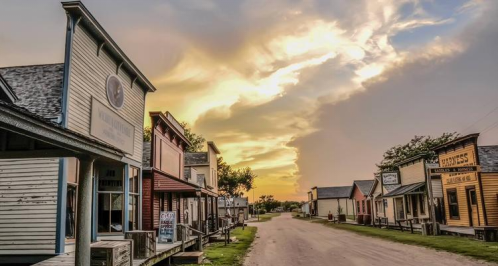
₋Old Cowtown Museum is an accredited history museum in Wichita, Kansas, United States. It is located next to the Arkansas River in central Wichita. The Museum was established in 1952, and is one of the oldest open-air history museums in central United States with 54 historic and re-created buildings, including a period farm and out-buildings, situated on 23 acres of land off the original Chisholm Trail. Cowtown is a combination of attraction, museum, living history site, and historic preservation project. It is a 501(c)(3) not-for-profit institution.
₋St. Private owners moved it twice then third move to Cowtown in 1952. The Museum focuses on life in Wichita during the last part of the 19th century. Cowtown's unique programming tells the story of Wichita's transformation from a frontier settlement to a cattle town to an agricultural and manufacturing area. Its artifact collection includes 12,000+ items dating from the period and ranging from farm wagons to tea spoons. The museum also contains a number of live animals, such as Percheron horses, a short-horned Durham milk cow, two sheep, a goat and chickens. The Old Cowtown experience includes costumed interpreters, hands-on activities, educational programming and a calendar of diverse events throughout the year.
₋Cowtown is accredited by the American Alliance of Museums, the highest national recognition achievable by a museum. Only 3% of all museums in the United States are accredited.
₋Early Wichita history
₋The first permanent settlement in Wichita was a collection of grass houses inhabited by the Wichita tribe in 1864. Pioneer trader Jesse Chisholm established a trading post at the site in the 1860s (whom the Chisholm Trail was named). Wichita was founded in 1868 by businessmen then incorporated as a city in 1870. The Chisholm Trail ran along the east side of Wichita from 1867 to 1871. In 1872 the Wichita and Southwestern Railroad completed a branch line from Wichita to the Atchison, Topeka and Santa Fe Railway at Newton. As a result, Wichita became a railhead for cattle drives from Texas, from which it has derived its nickname "Cowtown." Wichita's neighboring town on the opposite (west) bank of the Arkansas River, Delano, a village of saloons and brothels, had a particular reputation for lawlessness, largely accommodating the rough, visiting cattlemen. The Wichita/Delano community gained a wild reputation, however, the east (Wichita) side of the river was kept more civil, thanks to numerous well-known lawmen who passed through, employed to help keep the rowdy cowboys in line. Among those was Wyatt Earp. After railroads were extended west and south, Wichita lost the railhead for cattle drives along with the rowdy cowboys that came with it. In 1880, Delano was annexed by Wichita, then a land boom involving speculation occurred in the late 1880s, and by 1890 the population of Wichita had exploded to nearly 24,000.
₋Address: 1865 Museum Blvd, Wichita, KS 67203, United States
₋Phone: +1 316-219-1871
₋Website: https://www.oldcowtown.org/
VI.History
₋Early history
₋Archaeological evidence indicates human habitation near the confluence of the Arkansas and Little Arkansas Rivers, the site of present-day Wichita, as early as 3000 B.C. In 1541, a Spanish expedition led by explorer Francisco Vázquez de Coronado found the area populated by the Quivira, or Wichita, people. Conflict with the Osage in the 1750s drove the Wichita further south. Prior to European settlement of the region, the site was in the territory of the Kiowa.
₋19th century
₋Claimed first by France as part of Louisiana and later acquired by the United States with the Louisiana Purchase in 1803, it became part of Kansas Territory in 1854 and then the state of Kansas in 1861.
₋The Wichita people returned in 1863, driven from their land in Indian Territory by Confederate forces in the American Civil War, and established a settlement on the banks of the Little Arkansas. During this period, trader Jesse Chisholm established a trading post at the site, one of several along a trail extending south to Texas which became known as the Chisholm Trail. In 1867, after the war, the Wichita returned to Indian Territory.
₋In 1868, trader James R. Mead was among a group of investors who established a town company and surveyor Darius Munger built a log structure for the company to serve a hotel, community center, and post office. Business opportunities attracted area hunters and traders, and a new settlement began to form. That summer, Mead and others organized the Wichita Town Company, naming the settlement after the Wichita tribe. In 1870, Munger and German immigrant William "Dutch Bill" Greiffenstein filed plats laying out the city's first streets. Wichita formally incorporated as a city on July 21, 1870.
₋Wichita's position on the Chisholm Trail made it a destination for cattle drives traveling north from Texas to access railroads which led to markets in eastern U.S. cities. The Atchison, Topeka and Santa Fe Railway reached the city in 1872. As a result, Wichita became a railhead for the cattle drives, earning it the nickname "Cowtown". Across the Arkansas River, the town of Delano became an entertainment destination for cattlemen thanks to its saloons, brothels, and lack of law enforcement. The area had a reputation for violence until local lawmen, Wyatt Earp among them, began to assertively police the cowboys. By the middle of the decade, the cattle trade had moved west to Dodge City. Wichita annexed Delano in 1880.
₋Rapid immigration resulted in a speculative land boom in the late 1880s, stimulating further expansion of the city. Fairmount College, which eventually grew into Wichita State University, opened in 1886; Garfield University, which eventually became Friends University, opened in 1887. By 1890, Wichita had become the third-largest city in the state after Kansas City and Topeka with a population of nearly 24,000. After the boom, however, the city entered an economic recession, and many of the original settlers went bankrupt.
₋20th century
₋In 1914 and 1915, deposits of oil and natural gas were discovered in nearby Butler County. This triggered another economic boom in Wichita as producers established refineries, fueling stations, and headquarters in the city. By 1917, there were five operating refineries in Wichita with another seven built in the 1920s. The careers and fortunes of future oil moguls Archibald Derby, who later founded Derby Oil, and Fred C. Koch, who established what would become Koch Industries, both began in Wichita during this period.
₋The money generated by the oil boom enabled local entrepreneurs to invest in the nascent airplane manufacturing industry. In 1917, Clyde Cessna built his Cessna Comet in Wichita, the first aircraft built in the city. In 1920, two local oilmen invited Chicago aircraft builder Emil "Matty" Laird to manufacture his designs in Wichita, leading to the formation of the Swallow Airplane Company. Two early Swallow employees, Lloyd Stearman and Walter Beech, went on to found two prominent Wichita-based companies, Stearman Aircraft in 1926 and Beechcraft in 1932, respectively. Cessna, meanwhile, started his own company in Wichita in 1927. The city became such a center of the industry that the Aeronautical Chamber of Commerce dubbed it the "Air Capital of the World" in 1929.
₋Over the following decades, aviation and aircraft manufacturing continued to drive expansion of the city. In 1934, Stearman's Wichita facilities became part of Boeing which would become the city's largest employer. Initial construction of Wichita Municipal Airport finished southeast of the city in 1935. During World War II, the site hosted Wichita Army Airfield and Boeing Airplane Company Plant No. 1. The city experienced a population explosion during the war when it became a major manufacturing center for the Boeing B-29 bomber. In 1951, the U.S. Air Force announced plans to assume control of the airport to establish McConnell Air Force Base. By 1954, all non-military air traffic had shifted to the new Wichita Mid-Continent Airport west of the city. In 1962, Lear Jet Corporation opened with its plant adjacent to the new airport.
₋Throughout the late 19th and 20th centuries, several other prominent businesses and brands had their origins in Wichita. A. A. Hyde founded health care products maker Mentholatum in Wichita in 1889. Sporting goods and camping gear retailer Coleman started in the city in the early 1900s. A number of fast food franchises started in Wichita, beginning with White Castle in 1921 and followed by many more in the 1950s and 1960s including Pizza Hut in 1958. In the 1970s and 1980s, the city became a regional center of health care and medical research.
₋Wichita has been a focal point of national political controversy multiple times in its history. In 1900, famous temperance extremist Carrie Nation struck in Wichita upon learning the city was not enforcing Kansas's prohibition ordinance. The Dockum Drug Store sit-in took place in the city in 1958 with protesters pushing for desegregation. In 1991, thousands of anti-abortion protesters blockaded and held sit-ins at Wichita abortion clinics, particularly the clinic of George Tiller. Tiller was later killed in Wichita by an extremist in 2009.
₋21st century
₋Except for a slow period in the 1970s, Wichita has continued to grow steadily into the 21st century. In the late 1990s and 2000s, the city government and local organizations began collaborating to re-develop downtown Wichita and older neighborhoods in the city. Intrust Bank Arena opened downtown in 2010.
₋Boeing ended its operations in Wichita in 2014. However, the city remains a national center of aircraft manufacturing with other companies including Spirit AeroSystems and Airbus maintaining facilities in Wichita.
₋Wichita Mid-Continent Airport was officially renamed Wichita Dwight D. Eisenhower National Airport after the Kansas native and U.S. President in 2015.
VII.Other Information
₋Flood control
₋Wichita suffered severe floods of the Arkansas river in 1877, 1904, 1916, 1923, 1944, 1951 and 1955. In 1944 the city flooded 3 times in 11 days. As a result of the 1944 flood, the idea for the Wichita-Valley Center Floodway (locally known as the "Big Ditch") was conceived. The project was completed in 1958. The Big Ditch diverts part of the Arkansas River's flow around west-central Wichita, running roughly parallel to the Interstate 235 bypass. A second flood control canal lies between the lanes of Interstate 135, running south through the central part of the city. Chisholm Creek is diverted into this canal for most of its length. The city's flood defenses were tested in the Great Flood of 1993. Flooding that year kept the Big Ditch full for more than a month and caused $6 million of damage to the flood control infrastructure. The damage was not fully repaired until 2007. In 2019, the Floodway was renamed the MS Mitch Mitchell Floodway in honor of the man credited for its creation.
₋Utilities
₋Westar Energy provides electric power. Cox Communications and Spectrum offer cable television, and AT&T U-Verse offers IPTV. All three also offer home telephone and broadband internet service. Kansas Gas Service provides utility natural gas. The City of Wichita's department of Public Works and Utilities manages water provision and distribution, waste water treatment, and storm water drainage. Multiple privately owned trash haulers, licensed by the county government, offer trash removal and recycling service.
₋Health care
₋Via Christi Health operates three general medical and surgical hospitals in Wichita—Via Christi Hospital St. Francis, Via Christi Hospital St. Joseph, and Via Christi Hospital St. Teresa—and other specialized medical facilities. The Hospital Corporation of America manages a fourth general hospital, Wesley Medical Center, along with satellite locations around the city. All four hospitals provide emergency services. In addition, the U.S. Department of Veterans Affairs runs the Robert J. Dole VA Medical Center, a primary and secondary care facility for U.S. military veterans.
₋Transportation
₋Highway
₋The average commute time in Wichita was 18.2 minutes from 2013 to 2017. Several federal and state highways pass through the city. Interstate 35, as the Kansas Turnpike, enters the city from the south and turns northeast, running along the city's southeastern edge and exiting through the eastern part of the city. Interstate 135 runs generally north-south through the city, its southern terminus lying at its interchange with I-35 in south-central Wichita. Interstate 235, a bypass route, passes through north-central, west, and south-central Wichita, traveling around the central parts of the city. Both its northern and southern termini are interchanges with I-135. U.S. Route 54 and U.S. Route 400 run concurrently through Wichita as Kellogg Avenue, the city's primary east-west artery, with interchanges, from west to east, with I-235, I-135, and I-35. U.S. Route 81, a north-south route, enters Wichita from the south as Broadway, turns east as 47th Street South for approximately half a mile, and then runs concurrently north with I-135 through the rest of the city. K-96, an east-west route, enters the city from the northwest, runs concurrently with I-235 through north-central Wichita, turns south for approximately a mile, running concurrently with I-135 before splitting off to the east and traveling around northeast Wichita, ultimately terminating at an interchange with U.S. 54/U.S. 400 in the eastern part of the city. K-254 begins at I-235's interchange with I-135 in north-central Wichita and exits the city to the northeast. K-15, a north-south route, enters the city from the south and joins I-135 and U.S. 81 in south-central Wichita, running concurrently with them through the rest of the city. K-42 enters the city from the southwest and terminates at its interchange with U.S. 54/U.S. 400 in west-central Wichita.
₋Bus
₋Wichita Transit operates 53 buses on 18 fixed bus routes within the city. The organization reports over 2 million trips per year (5,400 trips per day) on its fixed routes. Wichita Transit also operates a demand response paratransit service with 320,800 passenger trips annually. A 2005 study ranked Wichita near the bottom of the fifty largest American cities in terms of percentage of commuters using public transit. Only 0.5% used it to get to or from work.
₋Greyhound Lines provides intercity bus service northeast to Topeka and south to Oklahoma City, Oklahoma. Bus service is provided daily north towards Salina and west towards Pueblo, Colorado by BeeLine Express (subcontractor of Greyhound Lines). The Greyhound bus station that was built in 1961 at 312 S Broadway closed in 2016, and services relocated 1 block northeast to the Wichita Transit station at 777 E Waterman.
₋Air
₋The Wichita Airport Authority manages the city's two main public airports, Wichita Dwight D. Eisenhower National Airport and Colonel James Jabara Airport. Located in the western part of the city, Wichita Dwight D. Eisenhower National Airport is the city's primary airport as well as the largest airport in Kansas. Seven commercial airlines (Alaska, Allegiant, American, Delta, Frontier, Southwest & United) serve Wichita Dwight D. Eisenhower National Airport with non-stop flights to several U.S. airline hubs. Jabara Airport is a general aviation facility on the city's northeast side. The city also has several privately owned airports. Cessna Aircraft Field and Beech Factory Airport, operated by manufacturers Cessna and Beechcraft, respectively, lie in east Wichita. Two smaller airports, Riverside Airport and Westport Airport, are in west Wichita.
₋Rail
₋Two Class I railroads, BNSF Railway and Union Pacific Railroad (UP), operate freight rail lines through Wichita. UP's OKT Line runs generally north-south through the city; north of downtown, the line consists of trackage leased to BNSF. An additional UP line enters the city from the northeast and terminates downtown. BNSF's main line through the city enters from the north, passes through downtown, and exits to the southeast, paralleling highway K-15. The Wichita Terminal Association, a joint operation between BNSF and UP, provides switching service on three miles (5 km) of track downtown. In addition, two lines of the Kansas and Oklahoma Railroad enter the city, one from the northwest and the other from the southwest, both terminating at their junction in west-central Wichita.
₋Wichita has not had passenger rail service since 1979. The nearest Amtrak station is in Newton 25 miles (40 km) north, offering service on the Southwest Chief line between Los Angeles and Chicago. Amtrak offers bus service from downtown Wichita to its station in Newton as well as to its station in Oklahoma City, the northern terminus of the Heartland Flyer line.
₋Walkability
₋A 2014 study by Walk Score ranked Wichita 41st most walkable of fifty largest U.S. cities.
₋Cycling
₋After numerous citizen surveys showed Wichitans want better bicycle infrastructure, The Wichita Bicycle Master Plan, a set of guidelines toward the development of a 149-mile Priority Bicycle Network, was endorsed by the Wichita City Council on February 5, 2013 as a guide to future infrastructure planning and development. As a result, Wichita's bikeways covered 115 miles of the city by 2018. One third of the bikeways were added between 2011, when the plan was still in development, and 2018.
₋The League of American Bicyclists added Wichita as one of 462 bicycle friendly communities to its Fall, 2017 list of Bicycle Friendly Communities, awarding it a bronze award.
VIII.Contact Information
Government
Type: Council-Manager
Mayor: Brandon Whipple (D)
City Manager: Robert Layton
City Hall
Address:
455 N Main
Wichita, KS 67202
Opening Hours
8am - 5pm (M-F)
CLOSED (Sa-Su)
Website: https://www.wichita.gov/Pages/default.aspx
